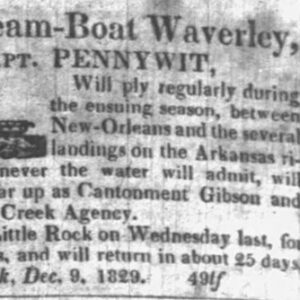calsfoundation@cals.org
Waverly [Steamboat]
The Waverly, under Captain Phillip Pennywit, was the first steamboat to ply the White River as far up as Batesville (Independence County), arriving there on January 4, 1831.
Phillip Pennywit was a veteran river boat captain who, in 1828, had established the first regularly scheduled service on the Arkansas River, going as far west as Cantonment Gibson in the Indian Territory (modern-day Oklahoma) with his vessel the Facility. In addition to moving freight and passengers, the Facility in June 1829 “had a keel-boat in tow, containing several Cherokee families, who are emigrating from the old nation …to the new nation, on the west side, of the Mississippi.”
In December 1829, Pennywit had a new boat, the Waverly, that was designed to navigate the low water on the upper Arkansas River. (Who built this boat, and when, is unknown.) The Waverly offered service “between New-Orleans and the several landings on the Arkansas River, and whenever the water will admit, will proceed as far up as Cantonment Gibson and the Western Creek Agency.”
Finding the “White River decidedly a better stream for navigation, than the Arkansas,” the captain decided to expand his services by going up the White, which no steamboats had previously ascended beyond Jacksonport (Jackson County). The journey was uneventful until the vessel neared the mouth of the Black River, where low water detained it for two days. The Waverly arrived at Batesville on January 4, 1831, “laden with merchandize [sic] for two houses in this place, and some goods destined for the Big North Fork above this place.” A correspondent to the Arkansas Times and Advocate wrote that “much credit is due to the enterprize [sic] of Capt. P. in thus opening new resources, and giving a fresh impetus to the enterprize [sic] and industry of the citizens of that part of our Territory.”
The writer also predicted that the Waverly’s pioneering visit would encourage immigration, holding that “we might with confidence, invite large slave-holders to explore the country; believing that they would succeed as well here in the culture of Cotton, Corn, Hemp, and Tobacco, as in any section of the world.”
The Waverly docked at Batesville for two days before leaving for New Orleans “freighting for our merchants upwards of two hundred Bales of Cotton, peltries &c, constituting about one half of the product of the River.”
Pennywit apparently sold the Waverly in 1832, the year after reaching Batesville. A November 30, 1832, advertisement in a Mississippi newspaper shows E. M. Lowe as the master of the vessel, saying “the Waverly has been hauled out and received thorough repairs and has excellent accommodations” and was then serving on the Red River in Louisiana. The Waverly’s ultimate fate is unknown.
Pennywit continued running steamboats on Arkansas waters, going from the Waverly to the Arkansaw, the Neosho, and the Little Rock before retiring in 1847 and establishing businesses in Van Buren (Crawford County). The paddleboat Philip Pennywit was built in 1849 by Pennywit and Captain Robert Beatty.
For additional information:
Arkansas Gazette, December 16, 1829, p. 4, col. 5.
Arkansas Gazette, January 6, 1829, p. 3, col. 5.
Arkansas Gazette, June 24, 1829, p. 3, col. 1.
Arkansas Times and Advocate, January 19, 1831, p. 3, col. 1.
Brown, Mattie. “River Transportation in Arkansas, 1819–1890.” Arkansas Historical Quarterly 1 (Winter 1942): 342–354.
“For Alexandria and Natchitoches” [Advertisement]. Mississippi Free Trader, November 30, 1832, p. 5.
Huddleston, Duane, Sammie Cantrell Rose, and Pat Wood. Steamboats and Ferries on the White River: A Heritage Revisited. Fayetteville: University of Arkansas Press, 1998.
Mark K. Christ
Central Arkansas Library System
 Louisiana Purchase through Early Statehood, 1803 through 1860
Louisiana Purchase through Early Statehood, 1803 through 1860 Transportation
Transportation Tunstall Gravestones
Tunstall Gravestones  Waverly Ad
Waverly Ad  Waverly Article
Waverly Article 




Comments
No comments on this entry yet.